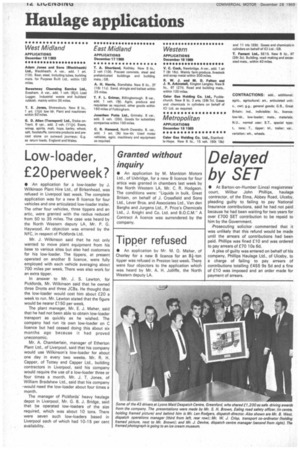Low-loader, E20perweek?
Page 14

If you've noticed an error in this article please click here to report it so we can fix it.
• An application for a low-loader by J. Wilkinson Plant Hire Ltd., of Birkenhead, was refused in Liverpool last week. The complete application was for a new B licence for four vehicles and one articulated low-loader trailer. The other four vehicles, three tippers and an artic, were granted with the radius reduced from 50 to 35 miles. The case was heard by the North Western deputy LA, Mr. P. G. Haywood. An objection was entered by the NFC, in respect of Pickfords Ltd.
Mr. J. Wilkinson said that he not only wanted to move plant equipment from his base to various sites but also had customers for his low-loader. The tippers, at present operated on another B licence, were fully employed with each vehicle averaging about 700 miles per week. There was also work for an extra tipper.
In answer to Mr. J. S. Lawton, for Pickfords, Mr. Wilkinson said that he owned three Drotts and three JCBs. He thought that the low-loader would cost him about £20 a week to run. Mr. Lawton stated that the figure would be nearer £150 per week.
The plant manager, Mr. E. J. Maher, said that he had not been able to obtain low-loader transport as quickly as he wished. The company had run its own low-loader on C licence but had ceased doing this about six months ago because it had proved uneconomic.
Mr. A. Chamberlain, manager of Etherton Plant Ltd., of Liverpool, said that his company would use Wilkinson's low-loader for about one day in every two weeks. Mr, R. H. Capper, of Tottey and Capper Ltd., building contractors in Liverpool, said his company would require the use of a low-loader three or four times a month. Mr. J. T. Jones, of William Bradshaw Ltd., said that his company -would need the low-loader about four times a month.
The manager of Pickfords' heavy haulage depot in Liverpool, Mr. G. B. J. Bridge, said that he operated low-loaders of the size required, which was about 10 tons. There were seven such low-loaders based in Liverpool each of which had 10-15 per cent availability.












































































